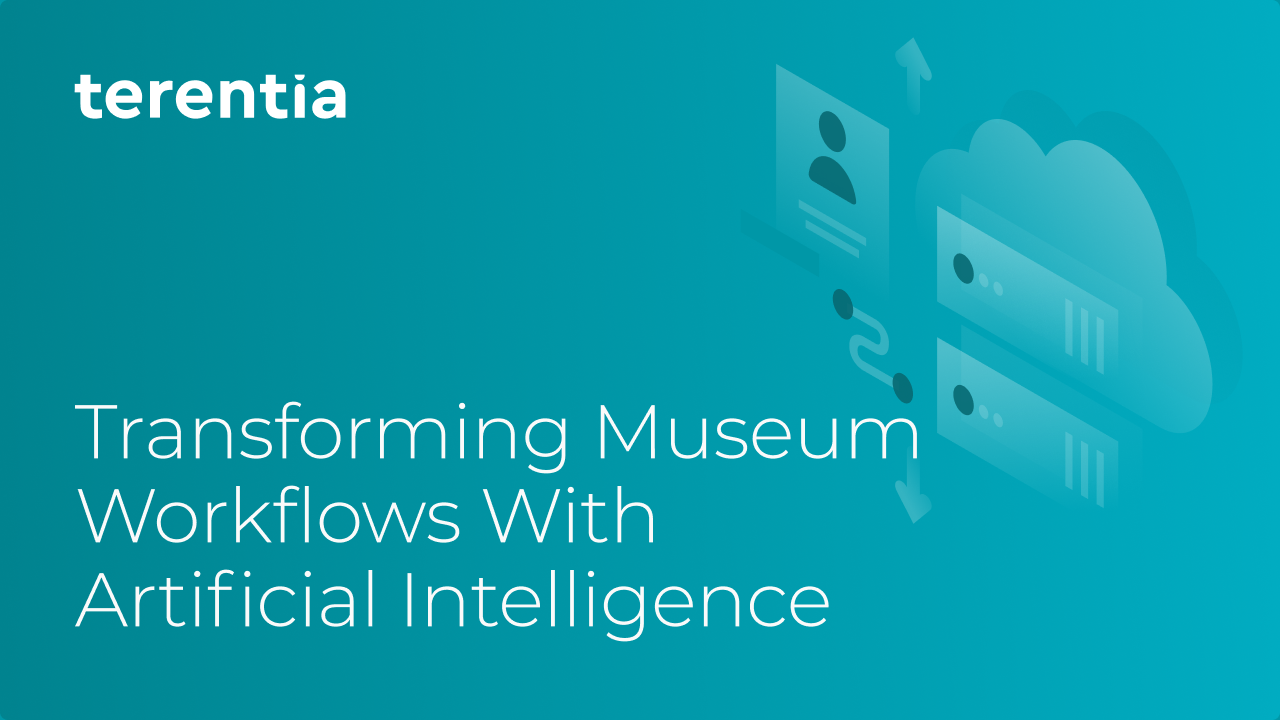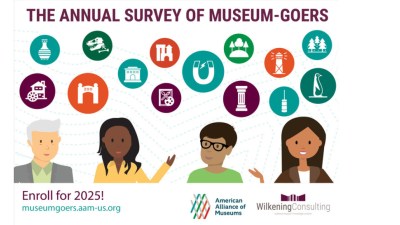
This post is an advertorial written by an organization that serves the museum field. The views, opinions, and positions expressed by the authors and those providing comments are theirs alone and do not necessarily reflect the views, opinions, or positions of AAM or its employees.
The future has arrived: artificial intelligence (AI) in museums is shaping a new era for the sector. But its emergence and increasing prevalence raise a new set of questions.
How much can AI really benefit our institutions? Won’t it be costly and time-consuming to start using it? And what about the ethical concerns we’ve all heard about?
In a sector where resources are often limited—and data integrity is paramount—it’s understandable why these queries would dominate discussions.
As AI enters “adolescence” in cultural institutions, its true potential continues to unfold. For museums ready to embrace innovation, the challenge of adapting is tempered by the exciting opportunities that AI offers.
Webinar series: Navigating AI for Museums
Delve into what AI means for the GLAM world with Terentia’s upcoming webinar series, Navigating AI for Museums: A Purposeful Approach to Innovation.
Register for our three-part event to explore ethical, practical, and effective AI applications in museum spaces and beyond.
Want our webinar updates delivered to your inbox? Subscribe to Terentia’s mailing list to never miss another event!
How can AI in museums help?
AI-driven solutions can offer a beacon of hope to museums facing more challenges than ever before.
After all, the demands on today’s institutions are immense—from meeting the evolving expectations of modern audiences to navigating cultural and societal shifts and reimagining exhibitions for physical and digital spaces. Time is a precious commodity, with budgets, resources, and staff under perpetual strain.
Some good news? Integrating artificial intelligence into collections management and digital asset management (DAM) can accelerate and streamline many of the day-to-day tasks that impede industry professionals.
Here are a few ways AI can support museums:
- Automate repetitive tasks: Boost efficiency and reduce human error by automating a range of tedious and time-consuming tasks with AI. That way, your staff can get back to focusing on high-value museum activities.
- Improve search and discovery: Locate collections items and digital assets with greater speed and accuracy, thanks to AI-based search tools whose functionality extends far beyond keyword matching.
- Support scaling activities: Have mountains of data waiting for processing? Or records to migrate? AI thrives on large volumes of information, making it ideal for scaling operations without overwhelming your team.
- Enhance metadata creation: Rich metadata is key to unlocking the full potential of your collections. AI-powered tools can analyze digital assets—such as photo, video, and audio files—and generate relevant keywords, descriptions, and category tags to boost discoverability much faster than manual cataloguing.
Are there downsides to AI for museums?
Of course, AI isn’t a magic bullet for museums. Nor does it offer an easy, one-size-fits-all solution to bottlenecked workflows, overwhelmed staff, and stretched budgets.
Like any technology, AI-powered solutions should be chosen, implemented, and used with care to meet your institution’s needs. Adopting AI also introduces new ethical and security considerations that museums must navigate.
When looking into AI tools for your museum, it’s important to keep these points in mind:
- Data privacy and security: Collections and audience data should never be inputted into AI systems without first confirming it would be secure and ethically handled. Museums must ensure all visitor data is collected with informed consent, anonymized to protect personal privacy, and processed in compliance.
- Bias and cultural sensitivity: Not all AI systems are trained equally. If the training data includes skewed info, social stereotypes, or a lack of diversity in perspectives and representation, AI can perpetuate or even amplify these biases in its outputs.
- Job displacement: AI’s ability to automate tasks—previously performed by museum staff—has raised concerns about whether it will replace certain roles or lead to job insecurity. Currently, AI functions best as a complement to human expertise, requiring employee oversight to verify its outputs. AI serves more as a “helper” than a “replacer” within museum ecosystems.
- Transparency and accountability: AI solutions can operate like “black boxes,” meaning it’s unclear how decisions are made or data processed. This lack of clarity can erode trust within museums, especially when using AI for curation or visitor interactions. (At Terentia, we prioritize transparency by publishing and adhering to an up-to-date AI use policy.)
- Resource allocation: Implementing AI can require investments in infrastructure, equipment, and training. Museums may need additional staff or consultants to bridge knowledge gaps, posing challenges for institutions with limited resources. Stakeholders might be reluctant to adopt AI or continue its use if the benefits aren’t immediately apparent.
- Selecting and adapting to AI solutions: Museums can struggle with assessing the overwhelming array of AI products and services on the market. Opting for an AI solution that isn’t industry-specific can also lead to a bespoke, project-oriented implementation that might work in the short term, but prove difficult to sustain over time.
With the right approach, these challenges are surmountable—and AI’s potential rewards can be transformative for museums.
Choosing museum software with built-in AI

Opting for museum software with integrated AI features is a simpler, more strategic option than trying to adapt generic AI tools to your workflows.
Terentia’s next-generation platform, for instance, is purpose-built for the GLAM sector and integrates artificial intelligence into its DAM and collections management solutions.
Powered by Microsoft Azure, our industry-specific applications deliver the true benefits of AI—unmatched efficiency, robust security, and powerful functionality—without the headaches that come with adapting to new technology.
Let’s explore the AI features that Terentia offers and what we’re launching next.
AI feature spotlight: Image tagging
Accelerate your museum’s image cataloguing workflows by leveraging AI to automate tagging.
Terentia AI identifies objects, people, text, and colors in image files and generates tagging keywords with an assigned confidence score. You can configure the platform to accept high-confidence keywords automatically or opt to review and approve them manually for added control.
Powered by Azure AI Vision, this feature delivers industry-leading accuracy for faster, more reliable image analysis.
AI feature spotlight: Video insights
Gain valuable insights and make your video content searchable in your digital asset management system (DAMS) with artificial intelligence.
Terentia can generate video transcripts, segment scenes, and detect and tag objects, faces, and emotions within frames. Elevate your indexing further with multilingual support, content moderation, and optical character recognition (OCR) to extract text appearing in videos.
This tool uses Azure AI Video Indexer to make your videos ready for discovery, accessibility, and creative reuse.
Feature spotlight: AI-powered OCR
Transform digital assets into discoverable data with AI-powered Optical Character Recognition (OCR).
Terentia’s OCR extracts text from documents, images, and even handwritten content to generate searchable transcripts from unstructured visuals. This AI tool streamlines access to your assets, making them easier to find and use.
With support for multiple languages, it helps preserve the linguistic diversity of your collections.
Terentia plans to roll out this new feature by spring 2025. Join our mailing list for the latest updates and product news.
What’s next on the AI roadmap?
Artificial intelligence continues to evolve and offer new possibilities for the GLAM sector.
To keep pace with these advancements, Terentia is dedicated to adding new AI-powered features to our museum software.
Wondering what’s coming next? Get a sneak peek into our AI roadmap for 2025 and beyond:
- Building links and relationships: Enrich connections between collections objects, people, and stories. Through advanced semantic analysis, AI can identify relationships and link related items based on shared themes, contexts, or creators. This forthcoming tool will enrich museum data and make it easier to uncover new insights and narratives.
- AI-powered search and discovery: Go beyond keyword-based search with Terentia’s upcoming AI-driven search. Find objects using natural language queries and leverage semantic search to uncover connections between objects, even when those connections aren’t directly tagged.
- Smart mapping and data imports: Recognize patterns, resolve inconsistencies, and create mappings between datasets for smoother, more accurate imports. This AI feature will be particularly useful for institutions updating legacy systems or merging collections from multiple sources.
Curious about adopting AI at your museum?
Artificial intelligence is here to stay in the museum world. If implemented with a responsible, ethically minded approach, AI technology can offer wide-reaching benefits to institutions looking for a fresh way to enhance their operations.
Wondering how AI could benefit your team? Start a conversation with Terentia.
We would be happy to discuss your museum’s needs and provide a live demo of our AI-powered solutions for DAM, collections management, and audience engagement.









Comments